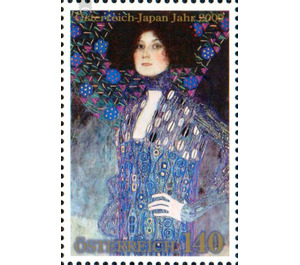joint issues - Austria / II. Republic of Austria 2009 - 140 Euro Cent
Theme: Art & Culture
| Country | Austria / II. Republic of Austria |
| Issue Date | 2009 |
| Face Value | 140.00 |
| Edition Issued | 200,000 |
| Printing Type | offset |
| Stamp Type | Commemorative |
| Item Type | Stamp |
| Chronological Issue Number | 2171 |
| Chronological Chapter | OOS-OE2 |
| SID | 517825 |
| In 28 Wishlists | |
The present, elaborately designed special issue block represents a philatelic premiere: Never before in the history of the stamp was there a joint issue of Austria and Japan - a mark of value that can be called a bridge between Europe and Asia. Dr. Peter Pantzer, Professor at the Bonn Institute for Oriental and Asian Studies, writes in his article "Between Nagasaki and Trieste - 140 years of friendly relations between Japan and Austria": "On October 21, 1868, two Austrian ships, the 'Danube' and the 'Archduke Frederick', her gaff, then the cloven-angel, to set sail from the port of Trieste. With the aim of Japan. A destination that had never been visited by any Austrian ship. "On September 19, 1869, the delegation finally reached Japan. In 2009 Austria and Japan celebrate 140 years of diplomatic relations. This festive year, celebrated in both Japan and Austria, highlights the close and traditionally good friendship between the two states in the light of greater attention. A rich program of events spans the year, a worth seeing exhibition at the Museum of Ethnology vividly documents the history of this friendship. However, the connection between the two countries not only affects economic aspects and active friendship, such as the 29 Japanese and Austrian partner cities, it is also evident in the artistic field: in music and porcelain art, in painting and architecture. Many famous artists were inspired by the expressions and styles of the other country to new works and the exotic language of form flowed into the art world. Especially in Art Nouveau, the influence of Japanese art is clearly felt. Uemura Shôen (1875 - 1949) was the most important painter of the Meiji, Taishô and early Shôwa period. Shôen became famous for her portrayals of beautiful women in typical Japanese style. The picture from 1936 from the Otani Memorial Art Museum in Nishinomiya City is titled "Autumn Clothes". Gustav Klimt (1862 - 1918), on the other hand, was one of the most important representatives of Viennese Art Nouveau. His portraits of ladies of society made him world famous. The picture from the year 1902, one of the highlights of the Vienna Museum, shown on the stamp, shows Emilie Flöge. In the background of the block motif you can see a lacquer tray with autumn grasses from the 16th century - this object is part of the collection of the MOA Museum of Art. The amphora-shaped vase, dated 1817, comes from the Vienna Porcelain Manufactory and can be admired in the Vienna Museum , The painter of the elegant floral arrangement is Josef Nigg.


